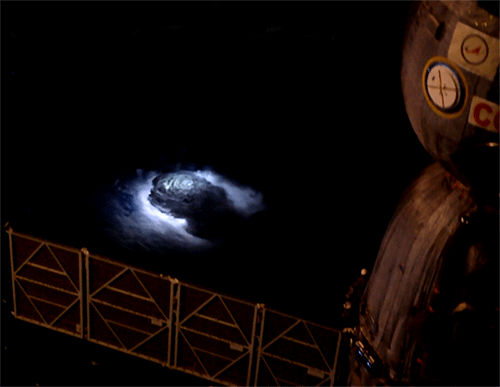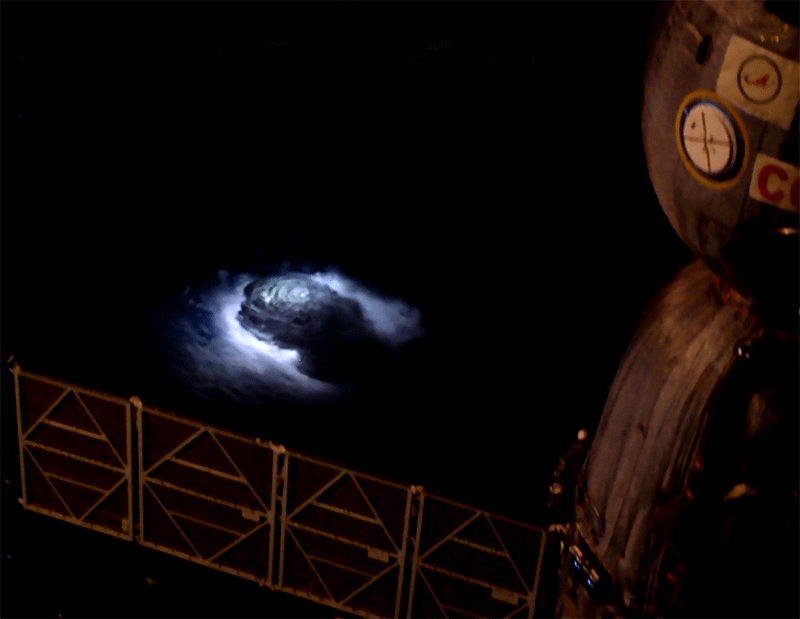Meetings: An Astronaut’s View of Thunderstorms
When a thunderstorm rolls in, we’re treated to a spectacle of bright white flashes followed by deafening cracks. But what is going on above the storm clouds? To find out, scientists teamed up with Danish astronaut Andreas Mogensen, who photographed storms raging over California, East India, Thailand, and Costa Rica from his perch several hundred thousand meters above Earth on the International Space Station (ISS). Pictures of the East Indian storm, which revealed far more lightning than expected, were presented in December 2016 at the fall meeting of the American Geophysical Union in San Francisco.
Scientists generally view thunderstorms from laboratories on the ground. But from there, it’s difficult to see past the dense, towering clouds to the sky above the storm. Researchers are uncertain, for example, about what kind of lightning flashes occur above a storm in the higher levels of Earth’s atmosphere “[This] region is poorly researched,” said Torsten Neubert, a physicist at the Technical University of Denmark, whose curiosity was piqued. For an elevated view, scientists have traditionally launched expensive equipment into space, or flown specialized aircraft to altitudes of 18,000 meters, almost twice the height of commercial plane routes. Neubert had a different idea: ask astronauts aboard the ISS to photograph a storm from high up. Mogensen’s images were part of a pilot test of the proposal, named Thor after the Nordic god of thunder.
But imaging thunderstorms from space isn’t as simple as an astronaut pointing a camera at Earth and pressing the shutter. Mogensen needed to know precisely when to be in position so that he could capture the storm as the ISS flew over it. “We had to make forecasts to ensure he would catch a storm,” said Olivier Chanrion, also from the Technical University of Denmark, who presented the findings in San Francisco. While Mogensen was circling Earth, Chanrion and colleagues were busy forecasting thunderstorms and transmitting their predictions to the ISS. Once they knew where to expect a storm, they used software to determine when it would be visible to the astronaut.
The team predicted four storms that Mogensen would be able to observe during his ten-day mission in September 2015, and he successfully captured them all. Chanrion described the storm images as “fantastic,” noting that they contained far more lightning flashes than the team had expected.
Chanrion said the East Indian storm captured on the evening of September 8th was the most spectacular. In Mogensen’s three-minute-long video, a segment of which can be found here, the tops of the storm clouds are constantly ablaze with flashes. Pulsating blue “jets” of lightning travel upwards from the cloud’s top, shooting to altitudes of 40 km, well past where the clouds end. A “sprite”—a flare tens of kilometers in size that originates high above the thunderstorm—explodes in the night sky. And all the while the cloud’s upper surfaces are awash with smaller flashes from blue discharges that dance to and fro every 30 seconds. The lightning is “popping all the time,” said Chanrion. “We were really surprised to see so much blue discharge.”
“The observations are the first of their kind,” said Neubert. He hopes Thor’s success will open the door to further imaging of thunderstorms by astronauts during the European Space Agency’s upcoming Atmospheric-Space Interactions Monitor project. The two-year experiment, which is set to begin in 2017, will survey the x-ray and gamma-ray emissions of thunderstorms from the ISS. Such data will enable scientists to better understand the origin of high-energy x-ray and gamma-ray flashes—which are also observed in lightning storms—and the impact of the flashes on the upper levels of the atmosphere. In the meantime, Chanrion and Neubert would like to keep Thor going, partnering with other astronauts to take more photos. “We don’t know why the blue discharges are so numerous,” Chanrion said. But he and his colleagues hope to find out.
–Katherine Wright





